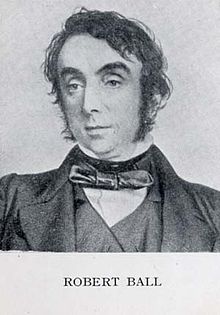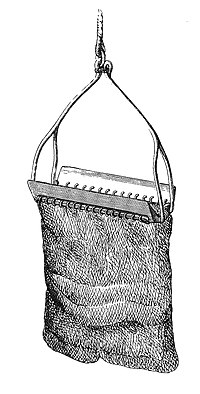
Sir Robert Stawell Ball was an Irish astronomer who founded the screw theory. He was Royal Astronomer of Ireland at Dunsink Observatory.
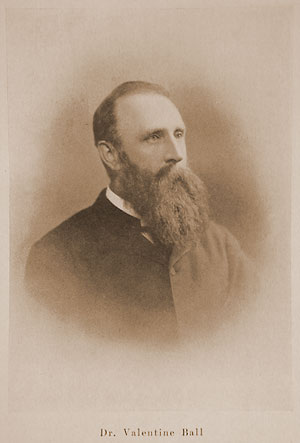
Valentine Ball was an Irish geologist, son of Robert Ball (1802–1857) and a brother of Sir Robert Ball. Ball worked in the Geological Survey of India for twenty years before returning to take up a position in Ireland.

Alexander Henry Haliday was an Irish entomologist. He is primarily known for his work on Hymenoptera, Diptera, and Thysanoptera, but worked on all insect orders and on many aspects of entomology.

Mary Ball (1812–1898) was an Irish naturalist and entomologist most noted for her studies of Odonata and for her discovery of the stridulation in aquatic bugs in the family Corixidae.

William Thompson was an Irish naturalist celebrated for his founding studies of the natural history of Ireland, especially in ornithology and marine biology. Thompson published numerous notes on the distribution, breeding, eggs, habitat, song, plumage, behaviour, nesting and food of birds. These formed the basis of his four-volume The Natural History of Ireland, and were much used by contemporary and later authors such as Francis Orpen Morris.

John Templeton (1766–1825) was a pioneering Irish naturalist, sometimes referred to as the "Father of Irish Botany". He was a leading figure in Belfast's late eighteenth-century enlightenment, initially supported the United Irishmen, and figured prominently in the town's scientific and literary societies.

Robert Lloyd Praeger was an Irish naturalist, writer and librarian.

William Henry Harvey, FRS FLS was an Irish botanist and phycologist who specialised in algae.

George Crawford Hyndman (1796–1867) was an Irish auctioneer and amateur biologist.
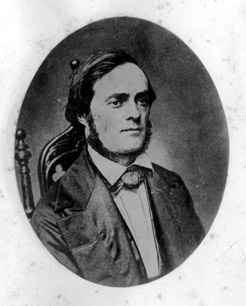
Arthur Adams was an English physician and naturalist.
William Spotswood Green was an Irish naturalist, who specialised in marine biology.

Edward Percival (Perceval) Wright FRGSI was an Irish ophthalmic surgeon, botanist and zoologist.
George Philip Farran (1876–1949) was an Irish zoologist. He was an expert on Copepoda.

The marine biology dredge is used to sample organisms living on a rocky bottom or burrowing within the smooth muddy floor of the ocean (benthic) species. The dredge is pulled by a boat and operates at any depth on a cable or line, generally with a hydraulic winch. The dredge digs into the ocean floor and bring the animals to the surface where they are caught in a net that either follows behind or is a part of the digging apparatus.

Anne Elizabeth Ball (1808–1872) was an Irish botanist, amateur algologist, and botanical illustrator. Born in Cobh 1808, Ball was a sister of naturalist Robert Ball and zoologist Mary Ball (1812–1898). The siblings became interested in natural history through the passion of their father, Bob Stawell Ball.
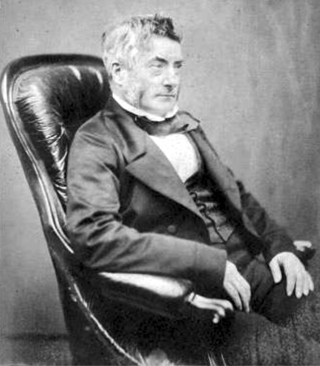
Robert MacAndrew was a British merchant and ship-owner, marine dredger, Fellow of the Royal Society, naturalist and collector of shells.

David Moore was a Scottish botanist who served as director of the Irish National Botanic Gardens for over 40 years.

Jane Stephens was an Irish zoologist who was considered a leading authority on sponges in Ireland with specialised knowledge in other marine life who identified and named over 40 sponges new to science. From 1905 to 1920 she was employed in the Natural History Division of the National Museum of Ireland working primarily on the collections of marine invertebrates, including taking part in the Clare Island Survey. Robert Lloyd Praeger testified to her knowledge of and work with Irish sponges stating that "Most of what we know of this group, whether marine or fresh-water, in Ireland, or off the Irish coasts, is due to her work."
Annie Letitia Massy was a self-taught marine biologist, ornithologist, and an internationally recognised expert on molluscs, in particular cephalopods. She was one of the founders of the Irish Society for the Protection of Birds in 1904. Many of the details of her life are unknown which is attributed to the fact that she is often described as a shy and retiring person, with no known photograph of her in existence.

The zoology museum of Trinity College Dublin was formed in 1777 at Regent House, Strand Street in Dublin, Ireland. Robert Ball on appointment as director (1844–1857), donated his personal collection, and was largely responsible for amassing most of the material by gift, purchase, through personal contacts and especially through the Dublin University Zoological Association. Thomas Coulter further strengthened the collections which came to include insect cabinets by James Tardy and John Curtis.
